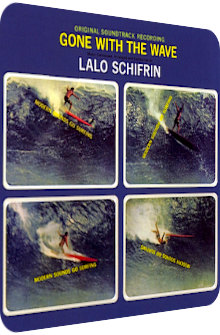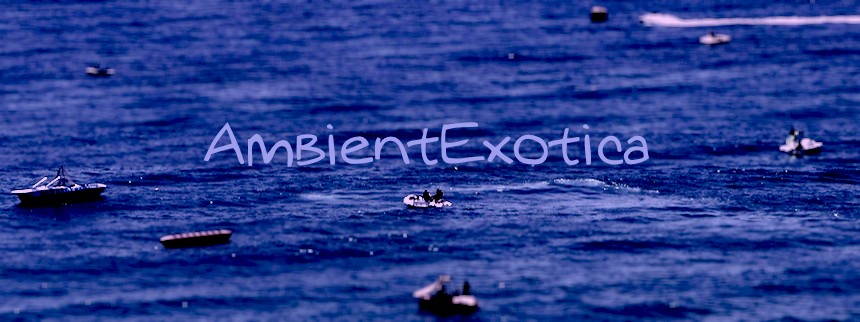
Lalo Schifrin
Gone With The Wave
1965
Every good movie needs a catchy theme; that’s a superfluous remark. However, back in the 60’s, high-class documentaries were also stuffed with superb soundtracks. Even better if these documentaries turn out to be based on the ever-growing surf movement such as Bruce Brown’s Barefoot Adventure (1961) which caused the eponymous album by Bud Shank. And thankfully, there’s more. Argentine composer, conductor and pianist Lalo Schifrin (born 1932), known for his prestidigitation in terms of his signature instrument, envisions an eleven-track journey among and within colorful beaches and surf sceneries on his album Gone With The Wave, the soundtrack to the documentary of the same name about a surfer’s lifestyle. Recorded in October 1964 in New York, conducted by Schifrin himself, produced by Stanley Wilson of Pagan Love (1961) fame and released in ’65 on the Colpix label, Schifrin gathers 13 musicians to underline the moving picture.
But something else happens: the band actually takes over once Schifrin is conducting! In hindsight, it is a delightful experience to scour through Lalo Schifrin’s records of the 60’s. One can say that about many composers, exotic or not, but here we have a case of a pianist and aural architect who floats through the genres and arrangements as if they were in close proximity to each other and as if permeating one after another were not that big a deal really. Gone With The Wave is such an album when it is approached in this context. Released after one of the most fantastic Latin/Exotica brass albums ever, Schifrin’s own New Fantasy (1964), Gone With The Wave is versatile, Latinized, exotified. Featuring the talent of Jazz guitarist Laurindo Almeida, pianist Victor Feldman, saxophonist-flutist Paul Horn and many others, the scintillating beach is worth the Exotica listener’s while, ready to be discovered in-depth.
Obviously, both film and album have to be kicked off with the refreshing breeze of their main title Gone With The Wave, an aureate insouciance made of Paul Horn’s jungular alto flute and Laurindo Almeida’s sun-dappled guitar. The backing chords by guitarist Howard Roberts may well be the force to turn these shaker-accentuated melodies together, as they shimmer through the interstitial decay phases every so often, promising freedom and jauntiness at the beach. The surface of the strings is gorgeously balmy, evoking anything but a ligneous mango diorama without any aggressive edge. The adjacent Laniakea Waltz is similarly soothing but inherits that Sunday spirit qua its Gospel-like brass stacks, Victor Feldman’s antediluvian piano blotches. Joe Mondragon’s double bass is also of note, always a silky adjuvant to reckon with in this get-together. Lalo Schifrin’s construction A Taste Of Bamboo (Hula Twist) however breaks everything apart with its strikingly exotic emanation: pentatonic marimba driblets, seething Rock-evoking piano keys, raspy guiros and Shelly Manne’s purposefully viscoelastic drums turn the concept around and create a stepbrother to The Out Islander’s Honorable Hong Kong Rock, as found on their LP Polynesian Fantasy (1961). Both tunes in tandem rock one’s Exotica luau, no matter their playful chintziness.
A short trip into the cocktail-laden Spy Jazz genre is undertaken in Halivea Blues, one slick but sleazy fellow with a tropical hue: the suspicious double bass billows meet the auspicious guitar moiré which is itself surrounded by luminescent piano sparks and Frank Rosolino’s protuberant trombone helixes. As the song progresses, its hotel lobby atmosphere is still audible, but veneered via parallax paroxysms that take the focus away from the former secret operation. A Flamenco follows next, the hoot-blooded Taco-Taquito, a zoetropic cavalcade that is driven by its humid-rubicund acoustic guitar, the Latinized leads, ghostly marimba airflows and saltatory piano prongs. These arabesques grow stronger and culminate, and even though they never explode within the kaleidoscopic sands, their endpoint – a sudden piano chord – is as similar to a cliff as it is a faithful finale to a faux gypsy treatment. Side A is then rounded off with Breaks, and it is here where Lalo Schifrin’s crew throws the textural experimentalism over board in favor of rhythmic Rock’n Roll of the jazzy kind. The agglutinated piano sounds much more glacial and accentuating, true, but the actual granuloma is based on Shelly Manne’s iridescently silvery hi-hats, the ardent horns and their interplay with the occasionally convoluted guitar copses. A tad more aggressive and vibrant, side A ends on a competitive note.
Side B starts in warm waters with Aqua Blues, a cautious hybrid of Dixieland-esque brass sinews and those archetypical double bass waves whose visibility carries the whole song. This very song eventually opens up and leaves its appended Harlem hue in order to feature a peninsular peritoneum of uplifting, sun-dried trombone notes. The upcoming Surf Waltz is made of a similar dualism, first bathing in alto flute pools and fir-green guitar cascades of the utmost dreamy kinds before a nocturnal aura kicks in by means of Jackie Kelso’s tenor saxophone which towers over the serrated elements of paradise. Almost tangible due to its plasticity, this showstopper of two minutes balances out the fight between jazzy eclecticism and the Surf-based fondness of memorable melodies. In this fight, the patterns and surfaces win, as they are the cornerstones for the moonlit seduction.
What follows is a glimpse into the shiny world of consumerism, at least from today’s viewpoint: Five By Four (Ala Moana) is a fast-paced drive through Honolulu’s eponymous shopping mall, its main ingredients being the prismatic guitar accompaniment near the frilly flute and eminently fizzling hi-hats whose texture reminds of large-grained maracas. This carefreeness is further absorbed by Breaks Bossa Nova, a liquedous dream made of coruscating piano polyhedrons, pentatonic but recondite guitar chords and freely flowing solos by Laurindo Almeida and Jackie Kelso. The album ends with the tunnel vision Waimea Bay, a fast-paced brass-heavy hillbilly ride through improvised coppices, a polylayered emphasis in the right moment and a victorious fanfare at its end.
A wonderful amalgamation of quartet-like arrangements envisioned by an ensemble of 13 luminaries, Gone With The Wave may induce a mediocre aftertaste since, you know, this is just music for a documentary, one which time forgot. One which did not leave a lasting impression, having literally gone with the wave to an unknown shore far away. As luck has it, Lalo Schifrin’s soundtrack is most definitely not the reason for this, as the personnel is up for the challenge, aptly playing all of Schifrin’s unique compositions in a playful and – if there is demand – melancholic way. Gone With The Wave is a slick and well-balanced affair, the surf guitars are never upfront, nor are the tone sequences arbitrary. A cool vibe is definitely attached, but it is the warmth and benignancy which make this an Exotica-compatible endeavor.
While Schifrin has taken elements of Jazz, Latin styles such as Samba and Flamenco, followed by an obvious dose of Surf Rock, their synthesis is actually tending toward mellower hues. The coolness of the gods of the waves has been reinterpreted and iterated throughout the decades, Surf Rock has never died – unlike that certain genre alloy that starts with an E – due to the dense range of possibilities and different textures. Gone With The Wave ultimately belongs to that very genre, Schifrin’s majestic and pompous string and brass fanfares are farther away than ever, making this a prismatic sparkler for fans of that quartet sound… even though thrice the amount of musicians simulates this notion. The album is available on vinyl and a remastered digital-only edition.
Exotica Review 450: Lalo Schifrin – Gone With The Wave (1965). Originally published on Sep. 12, 2015 at AmbientExotica.com.
